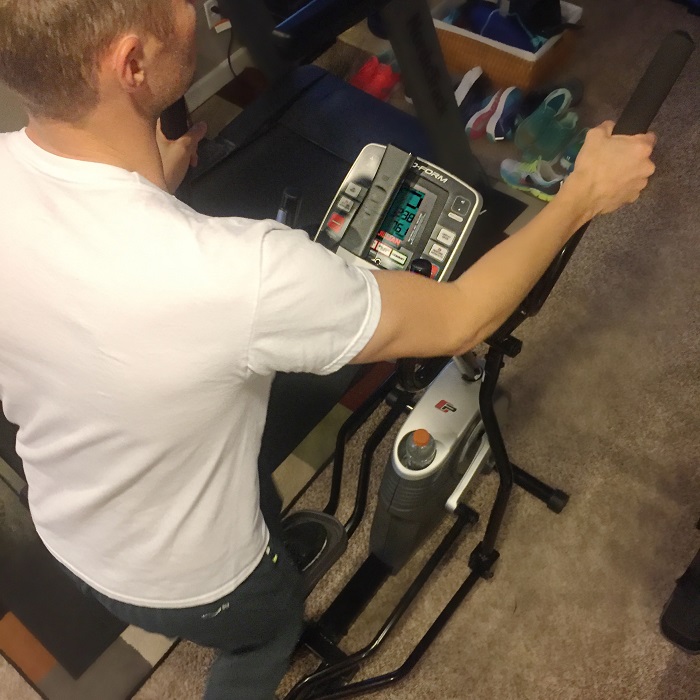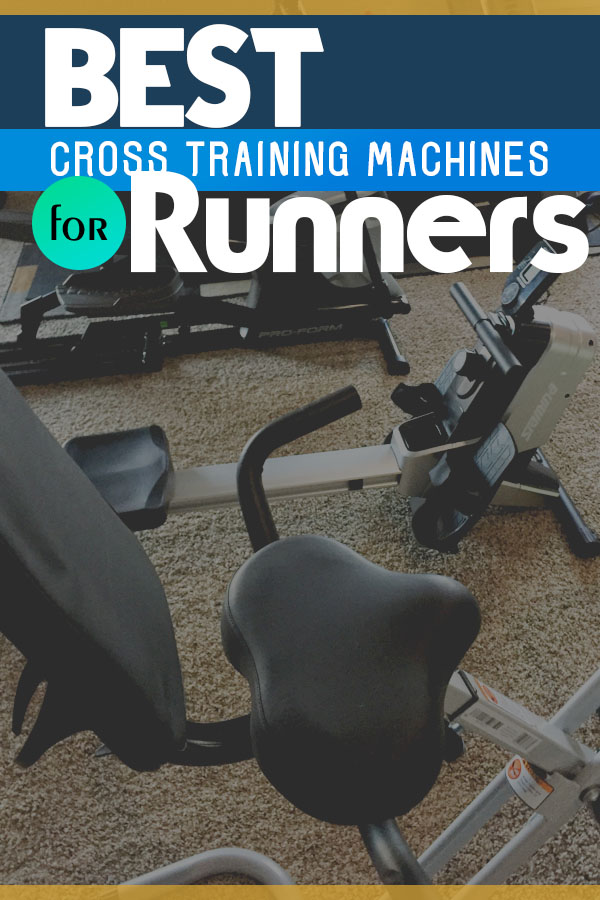Cross training machines for runners can be truly useful in times of injury or to extend cardio fitness with less impact. But which machines are going to give you the most bang for your time and how to use them most effectively?

Cross training machines like the elliptical, rowing machine, ski ERG, and bikes offer a low impact way to strengthen muscles and joints. Plus, they often allow us to hit muscles in a different way than running, which both makes them stronger and gives us a little recovery.
While more running is generally going to make you better at running, that only applies if you are able to fully recover from the workouts. For some using a machine in place of a run each week allows them to keep their HR up for a workout, but give the hamstrings, calves and joints a chance to better recover.
If you’ve been wondering which cardio machine is good for runners and how it compares to running, you’ll love this article. We’ll cover the various options and you can make this work at home or the gym depending on your long term goals.
Remember that cross training is also really beneficial for longevity, not just in running, but total health.
Best Cross Training Machines for Runners
As a runner, it’s important to mix up your workouts to challenge different muscle groups and avoid overuse injuries. At least, this running coach hopes that I’ve drilled it in to you.
Cross training can be your secret weapon to become a better runner. It strengthens your muscles, increases your endurance, and gives your joints a break from the constant impact of running.
While my first pick is always going to be for you to spend time doing some of the strength training for runners workouts we’ve compiled, I understand that sometimes we need cardio!
Here are some of the best cross training activities for runners.
#1 Rowing Machine for Runners
A rower is a great piece of home gym equipment that can provide a high-intensity workout.
It’s a low impact machine, which means it’s kind on your joints and tendons, plus it’s going to give you a chance to really engage your core and upper body. This makes it a perfect cross-training tool for runners.
Rowers work on multiple muscle groups at once, including your quads, glutes, hamstrings, calves, and upper body muscles. This full-body workout can help runners build strength and endurance, which are key to becoming a better runner.

Benefits of Rowing Machine for Runners
We added a Hydrow machine to our home gym a few years ago and it’s become a once a week staple for both my husband and I. As a mountain biker, he sees the power it’s created in his legs to climb hills and I honestly love just working my upper body differently.
- It’s a full body workout engaging your legs, arms, back and core
- Creating strength in your core helps to improve posture, which keeps the chest open for better breathing
- Low impact option to do HIIT workouts for fast twitch muscle fibers
- Doing intervals on the rower can improve lactate threshold, meaning more power for that final kick
Fun little showdown: Running vs Rowing which is a better workout >>
How Long on a Rower Equals to 1 Mile Run
You might be wondering how long you’d need to row to match a 1-mile run. Well, it’s not an exact science due to factors like intensity, your energy expenditure, and individual fitness levels.
But some research suggests that, on average, row for about 12-15 minutes at a moderate intensity to mimic the benefits of a 1-mile run.
Remember, it’s not just about duration. Keep an eye on your heart rate and your strokes per minute (or cadence) to ensure you’re getting a good cardio workout.
Have a purpose for your time on the machine, whether that’s replacing a long easy run or a speed session.
#2 Elliptical Machine for Runners
Using an elliptical machine regularly can help you become a better runner by improving your endurance and cardiovascular system. In theory this machine most closely mimics running and so it’s often the go to for many runners.
Admittedly, it’s my least favorite machine and I can’t really tell you why…but it does work!
Once again, we get an extra benefit because elliptical training involves not just the quads, glutes and calves, but the arms, back and core; allowing us to utilize muscles that we might not as forcefully during a run. But your upper body is key to a good run, so that extra strength will pay off.
Monitoring your cadence (strides per minute) and RPM (revolutions per minute) on the elliptical can help you mimic your running workout. I.e. you’d be looking for 90 RPM ORRRR I would say use the elliptical on a higher resistance and make it more like a hill workout.
Plus, the energy expenditure and oxygen consumption are very similar to running, making it an excellent alternative for runners.

Benefits of Elliptical Machine for Runners
The elliptical machine is a popular choice among runners for cross training.
- Elliptical is the closest to running in terms of stride and engaging the full leg muscle
- Great for adding power to climb hills
- For an intense workout, aim to keep your HR about 70% of your max
- Use your arms to get in a good upper body workout, this too will help when you are climbing hills
- Alternate forward pedals with backward to also work your calves and hamstrings to help strengthen your knees
- Use it on active recovery days or when you need an easy run, but feel less energetic
How Many Strides on an Elliptical Machine Equals to 1 Mile Run
This can be a bit tricky to answer because it depends on several factors, including the length of your stride and the intensity of your workout.
On average, conditional research shows that around 2,000 strides on an elliptical machine could be equivalent to a mile run. However, this will vary from person to person.
For instance, if your stride length is longer, you may require fewer strides to cover a mile. Similarly, if you’re working at a higher intensity or rpm (revolutions per minute), you might cover a mile in fewer strides.
In terms of time, working out on an elliptical machine for approximately 10-minutes at moderate intensity would equal to a mile.
#3 Stationary Bike for Runners
If you’re a runner looking for a great cross-training workout, don’t overlook the stationary bike. This gym staple is a low impact, high-intensity option that can help you build endurance without putting stress on your joints.
Many runners turned to Peloton a few years ago and have said it’s definitely improved their running. This in no way surprises me as every triathlete I talk with feels like they recover faster because they no longer only do running. Their long bike days are still less strain on bones, tendons and ligaments so they feel better (plus fueling on the bike is way easier when your stomach is bouncing around).
As you pedal, you’ll be working your quads, hamstrings, glutes, and calves. This can help improve your strength and endurance for those long runs.
Using a stationary bike also allows you to control your workout intensity. You can adjust the resistance to simulate hills or increase the rpm for a speed workout. For some of you having an instructor allows you to really push the effort in ways you might not on a solo run.
Plus, cycling can help improve your running cadence, which is beneficial for your running fitness. A higher cadence can make your strides more efficient, reducing energy expenditure and increasing your overall running performance.

Benefits of Stationary Bike for Runners
Stationary bikes are an excellent piece of home gym equipment for any runner.
- Without the pounding, you can often ride much longer than you can run which will help with endurance
- You’ll utilize different leg muscles creating a more balanced body (injury free!) and more powerful legs
- You can again focus on a low impact long easy ride or a HIIT session that’s still easier on your joints
- Faster recovery time than running means it won’t inhibit your other workouts
- Increasing the tension creates more strength than uphill running. If you live in a flat area and need train for a hilly race, cranking up the resistance on your bike will work!
Just remember if you are going hard, that this still counts towards your overall 20% hard for the week. The body doesn’t care if it’s running or cycling.
How Many Miles of Cycling on a Stationary Bike Equals to 1 Mile Run
If you’re a runner looking to switch up your workouts, cycling can be a great alternative, whether inside or outside. But how much cycling equals a mile of running?
It’s not a straight swap. A general rule of thumb is that 1 mile of running is roughly equal to 3 miles of cycling.
This can vary depending on the intensity of your workout, your cadence (rpm), and your personal energy expenditure.
In terms of time, on average, cycling at a light speed would take you 16 minutes to equal one mile of running. At a moderate pace, it would take 11 minutes, and at a vigorous pace, it would take 8 minutes to equal to a mile of running.
#4 Stair Climber for Runners
It mimics the action of climbing stairs, but with increased intensity. This means it’s a high-energy expenditure workout that can really get your heart rate pumping. I mean what runner hasn’t thought to themselves “how can I run for miles but feel out of breathe on the stairs?!”
It might be low impact, but it’s requiring you to work much harder.
With every step you are now lifting up your bodyweight!
This is another machine that I find many ultrarunners really like to mix in because it helps to mimic some of those huge vertical gains.
One study showed that those on the stair climber increased their VO2 Max more than runners!
Benefits of Stair Climber for Runners
Let’s look at what this lung busting machine helps with:
- Overall cardio endurance builder
- Great to replicate long hills and build quad strength
- Not ideal to replace an easy run (unless you are good at watching HR), consider it more like a plyometric workout
- Checkout these great stair workouts for runners
How Long on a Stair Climber Equals to 1 Mile Run
The duration on a stair climber equivalent to a 1-mile run can vary based on the intensity of your workout.
If you’re maintaining a moderate intensity, it might take approximately 15 minutes on a stair climber to equal a mile run.
This is because stair climbing requires a higher energy expenditure than running due to the upward motion, which engages more muscle groups.
However, it’s not just about the duration. Pay attention to your heart rate too. Aim for a heart rate that’s 70-85% of your maximum to ensure you’re getting a good cardio workout.
Of course you know that cardio isn’t the only cross training we need to do, so here are a few more things to keep in mind!
Looking for more Cross Training Tips?
Do you have any machines at home?
What’s your cardio cross training machine of choice?
Other ways to connect with Amanda
Instagram: RunToTheFinish
Facebook: RunToTheFinish
Get every new post delivered to your inbox



